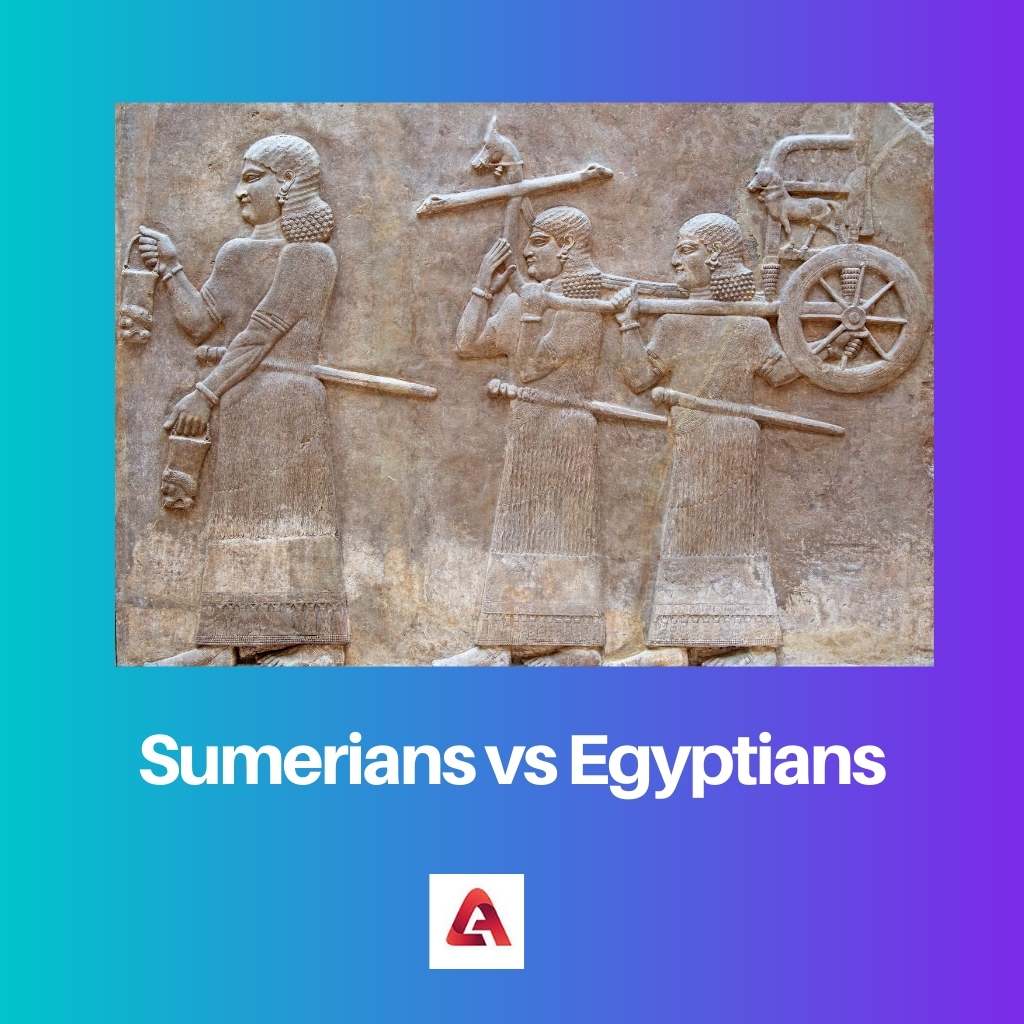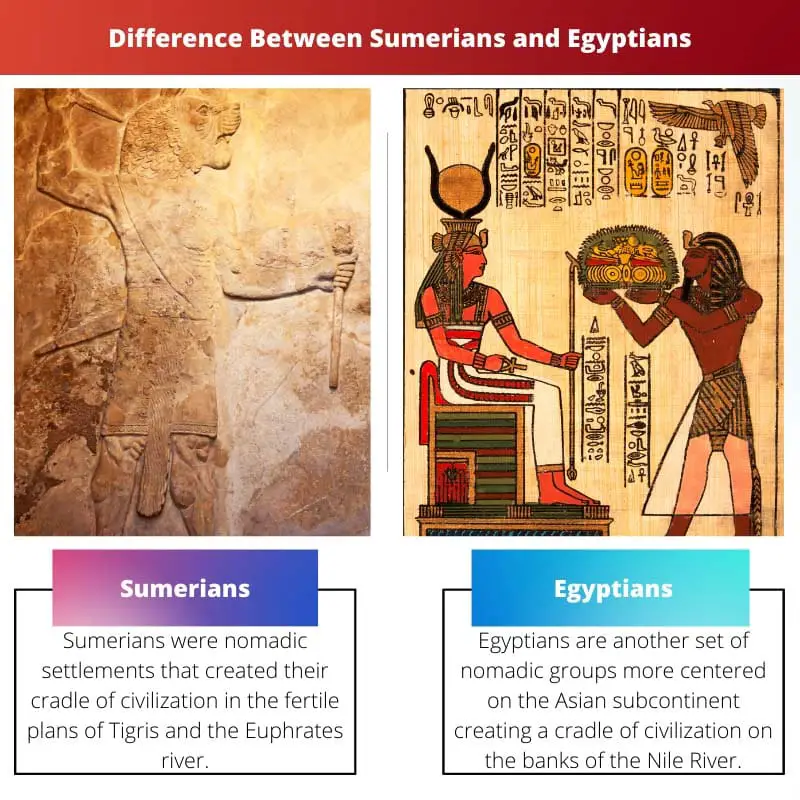Sumerians and Egyptians are age-old civilizations that gave birth to most of the modern-day technologies and teachings. They both came into the settlement at almost the same time.
They are among the first nomadic people to settle in a place. Both chose to live around the rivers and plains that are highly rich in nutrients and have high agricultural output.
Key Takeaways
- Sumerians developed the first writing system called cuneiform, while Egyptians created hieroglyphics.
- Sumerians built ziggurats as religious structures, while Egyptians constructed pyramids as tombs for their pharaohs.
- Sumerians established the earliest known urban civilization in Mesopotamia, while Egyptians created a civilization along the Nile River.
Sumerians vs Egyptians
The Sumerians lived in Mesopotamia, in what is now Iraq, from around 4000 BCE to 2000 BCE. They developed the world’s first writing system. The Egyptians lived in the Nile River Valley in what is now Egypt, from around 3100 BCE to 30 BCE. They are known for their sophisticated system of writing.

Sumerians were nomadic settlements that created their cradle of civilization in the fertile plans of Tigris and the Euphrates river. They have created wonderful writing methods that gave birth to modern-day writing styles.
Their nomadic lifestyle came to an end by the discovery of the possibility of agriculture flourish that can happen in the Tigris banks.
Egyptians are another set of nomadic groups more centered on the Asian subcontinent creating a cradle of civilization on the banks of the Nile River.
Their writing methods brought a breakthrough in the history of human writing that persists to decode age-old scriptures. Just like in the case of Sumerians, their nomadic lifestyle came to a similar end to start an orderly life with discipline.
Comparison Table
| Parameters of Comparison | Sumerians | Egyptians |
|---|---|---|
| Writing Form | Cuneiform | Hieroglyphics |
| Ruling Power | Divided | Only upon the Pharaoh |
| Evolved Around | 4500 BC | 3150 BC |
| Writings Documented on | Clay | Papyrus |
| Gods | Heaven, Earth, Air, and Water | Over 2000 gods with the Pharaoh as the ruler |
What is Sumerians?
Sumerians are an old civilization also called the Mesopotamians. “Sumer” translates to the land of the civilized Lords, which might indicate its political system.
They have settled in the banks of the Tigris and the Euphrates River, around 4500 BC.
This flood plain settlement is because there were greater chances for the growth of food crops for the survival of the people.
This attracted the nomadic group to the banks of the Tigris that provided nutrient-rich soil to enhance agricultural development.
The Sumerian settlement is present-day Iraq which still holds remnants from the old settlement like the agricultural equipment and scriptures of their advanced developments.
The religious approach of the Sumerian nomads revolved around the four gods who were considered as the protectors of the world and the major aspects of the earth.
The four deities were “The God of Heaven”, “The God of Air”, “The Goddess of Earth”, and “The God of Water”.
Though the Sumerian people had a religious element in the society, they were not considered as a theocracy society, which means that no one represented God.
No priests or Lords were in charge of running any religious or governmental institutes.
The geographic conditions of Mesopotamia were always volatile and the people led a dangerous life due to the environmental resistance of the land.
Due to this vulnerability of the area and the constant death of the people in the settlement, the Sumerian settlement never did take death seriously.
They don’t have any elaborate preparations to send the dead off nor do they prepare for the afterlife in any way that might make it seem like it’s a big deal for celebrations.
The Sumerian civilization could be considered among the first set of people to introduce a method of communication and speech.
They developed a writing technique that had been christened Cuneiform. This name came from the device that was used by them to write which had a wedge-shaped structure.
This writing was etched onto clay fragments that were later put onto fire kilns to harden the clay, thereby making the scripts last long.
A big demerit of the clay etching method is that it is expensive in production and difficult to write on.
Sumerian civilization had always been known to be a technologically advanced settlement to overcome their harsh climatic conditions.
The unpredictable environmental resistance gave birth to the rise of technology used by the Sumerians.

What is Egyptians?
The Egyptians are the most commonly heard of an old civilization with a greater role to play in developing the modern-day element.
The nomadic Egyptians settled on the banks of the Nile River that had a great soil quality to give to the settlers to provide for them.
The agricultural technology developed by the Egyptians persists to this day. Their developments had been to make the most use of the available land and utilize the nutrients present in the soil.
The Egyptians believed in worshipping a large number of Gods.
They are known to have worshipped over 2000 Gods and goddesses with the Pharaoh who was considered as a living God, making the Egyptians a non-theocracy society.
Due to their vast belief in gods and goddesses, they were considered well protected from the natural disasters that nature threw at them.
They are also known to worship animals especially cats and were also known to mummify their pets once dead to prepare them for their afterlife.
Their lives all revolved around looking forward to the future and well-prepared and elaborate celebrations for the ones who die as a way of preparing for the afterlife.
Their passage to the afterlife was celebrated. The dead are considered to have a comfortable journey as they are provided with desiccated food and fruits to last them throughout the journey.
The writing method of the Egyptians was called hieroglyphics. This is derived from the many signs and drawings of the ancient Greeks.
The hieroglyphic writing style persists to this day for the recognition of the Egyptian scriptures.
The writing was done on papyrus papers that were derived from a reed, thus making the process cheap yet efficient.
The papyrus made the information stored easier to archive due to the lack of bulky storage material, thereby starting the record-keeping tradition.
The power to rule resided totally in the hands of the Pharaoh leading the Egyptians to live in an authoritarian society.
They are considered as the creators of the pyramids, a wonder in nature and a breakthrough in architecture.
The Egyptians were great warriors who were feared by the later settled civilizations.

Main Differences Between Sumerians and Egyptians
- While the Egyptians had more than 2000 gods and goddesses to worship along with a sole ruler, the Pharaoh the Sumerians had only four gods who they believed to be the protectors of the earth.
- When the Sumerians were frequently thundered with natural disasters that the land around them bestowed, the Egyptians had a more secure surrounding with much fewer calamities.
- The Sumerians had a clear government system where the politics were diluted through the input from stately nobles whereas, in the Egyptian system, only the Pharaoh had the authoritarian right to make decisions.
- The Sumerians held no importance for the afterlife or gave no proper send-off to those who die, the Egyptians thought otherwise and send-off their dead with the greatest of celebrations and a coffin filled with all that they require for their journey to the afterlife.
- The writing of the Sumerians was done on clay making record keeping hard as the clay tablets tend to be more delicate and bulky to store. But the writings of Egyptians being done on the Reed papyrus held a great possibility for storage and hence a track of the records stored.

- https://books.google.com/books?hl=en&lr=&id=IuxIdug8DBUC&oi=fnd&pg=PA3&dq=sumerians&ots=wFJ6eXtjmx&sig=BzPd70xEQiP9RLpwfMC8zQrNLuA
- https://books.google.com/books?hl=en&lr=&id=RBQYAAAAYAAJ&oi=fnd&pg=PR12&dq=ancient+egyptians&ots=6kDBeviUbA&sig=rChzYvQudh6mQJBZpnmnJ_1YQUk

A thought-provoking read! It’s intriguing to learn about the distinct religious, cultural, and technological aspects of the Sumerian and Egyptian societies.
An interesting comparison! It’s fascinating to see the similarities and differences between these two ancient civilizations and how they contributed to modern technologies and teachings.
I completely agree! These civilizations played a crucial role in the development of human history and it’s important to study their legacy.
Ah, the timeless debate of Sumerians vs. Egyptians. It’s remarkable to observe the impact of these ancient civilizations on our world today. Who would’ve thought that ancient writing systems could shape the future of communication?
I appreciate the thorough breakdown of the Sumerian and Egyptian civilizations. The historical context provided is extremely enlightening.
This article oversimplifies the complexities of these ancient civilizations. There are nuances that are overlooked in this comparison.
I agree with your viewpoint. It’s important to consider the multifaceted nature of these civilizations rather than painting them with broad strokes.
The comparison of the writing forms and ruling structures of Sumerians and Egyptians provides valuable insights into the early stages of human development.